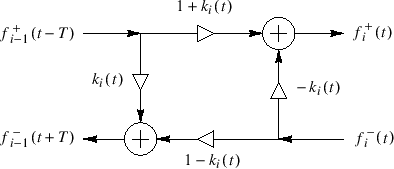Next |
Prev |
Up |
Top
|
Index |
JOS Index |
JOS Pubs |
JOS Home |
Search
By factoring out  in each equation of (C.60), we can write
in each equation of (C.60), we can write
where
![$\displaystyle f_{{\Delta}}(t) \isdef k_i(t)\left[f^{{+}}_{i-1}(t-T) - f^{{-}}_i(t) \right]$](img3619.png) |
(C.63) |
Thus, only one multiplication is actually necessary to compute the
transmitted and reflected waves from the incoming waves in the
Kelly-Lochbaum junction. This computation is shown in Fig.C.21,
and it is known as the one-multiply scattering junction [299].
Figure C.21:
The one-multiply scattering junction.
![\includegraphics[scale=0.9]{eps/Fom}](img3620.png) |
Another one-multiply form is obtained by organizing (C.60) as
where
As in the previous case, only one multiplication and three additions are
required per junction. This one-multiply form generalizes more readily to
junctions of more than two waveguides, as we'll see in a later section.
A scattering junction well known in the LPC speech literature but not
described here is the so-called two-multiply junction [299]
(requiring also two additions). This omission is because the two-multiply
junction is not valid as a general, local, physical modeling building
block. Its derivation is tied to the reflectively terminated, cascade
waveguide chain. In cases where it applies, however, it can be the
implementation of choice; for example, in DSP chips having a fast
multiply-add instruction, it may be possible to implement the inner loop of
the two-multiply, two-add scattering junction using only two instructions.
Next |
Prev |
Up |
Top
|
Index |
JOS Index |
JOS Pubs |
JOS Home |
Search
[How to cite this work] [Order a printed hardcopy] [Comment on this page via email]
![]() in each equation of (C.60), we can write
in each equation of (C.60), we can write